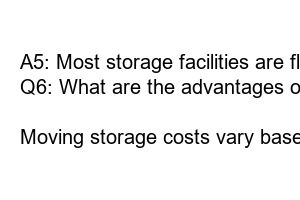이삿짐 보관비용
Title: Moving Storage Costs: Budgeting for Convenience and Security
Introduction:
Moving to a new home can be both an exciting and overwhelming experience. Alongside the logistical challenges of transporting your belongings, there’s the added consideration of finding suitable storage solutions. Whether you’re downsizing, renovating, or simply in need of extra space, it’s essential to plan for the costs involved in moving storage. In this article, we’ll explore the various factors that influence moving storage costs and provide valuable insights to help you make an informed decision.
Subheading 1: Determining Your Storage Needs
To estimate the storage space required, evaluate the quantity and dimensions of your belongings. Categorize items that are frequently used and unlikely to be stored, and consider seasonal items that may need long-term storage. By analyzing your storage needs, you can find a suitable storage facility that balances affordability with the necessary space.
Subheading 2: Location and Accessibility
The location of the storage facility can significantly impact the overall cost of moving storage. Opting for a facility closer to your new home may offer convenience, but it can also be costlier. Facilities located in urban areas tend to have higher rental rates compared to those in suburban or rural locations. Additionally, consider assessing the facility’s accessibility, security measures, and operating hours to ensure it meets your requirements.
Subheading 3: Type of Storage Unit
Storage units come in various sizes and types, each having its associated costs. Typically, the four main types of storage units are traditional storage units, climate-controlled units, portable storage containers, and warehouse storage. Understanding the differences between these options and their corresponding price ranges will help you choose the most suitable one for your needs.
Subheading 4: Insurance and Security
While insurance and security measures may seem like additional expenses, they are crucial investments to safeguard your belongings. Reputable storage facilities offer insurance options tailored to protect your items from unforeseen events such as theft, fire, or damage. Assess the different coverage options available and factor their costs into your budget.
Subheading 5: Additional Services and Amenities
Some storage facilities provide additional services and amenities that enhance convenience and ease. For instance, offerings such as 24/7 access, loading and unloading assistance, packing supplies, and even transportation services can simplify your moving and storage experience. Consider these value-add services when comparing costs to determine the best fit for your requirements.
Subheading 6: Duration of Storage
The duration of storage plays a significant role in determining the overall cost. Most storage facilities offer flexible rental terms, allowing you to choose between short-term or long-term storage options. It’s vital to weigh the costs of both scenarios and thoroughly evaluate your storage needs to ensure you aren’t overpaying for unnecessary storage time.
Frequently Asked Questions:
Q1: What are the average moving storage costs?
A1: Moving storage costs vary based on factors such as location, unit size/type, duration of storage, and additional services. On average, you can expect to pay between $50 and $300 per month.
Q2: Do I need insurance for my stored items?
A2: While it’s not mandatory, securing insurance is highly recommended to protect your belongings from potential damage, theft, or unforeseen circumstances. Check with your storage facility for insurance options.
Q3: Can I access my belongings at any time?
A3: Many storage facilities offer 24/7 access to ensure you have convenient access to your items whenever needed. Be sure to verify the facility’s operating hours and accessibility policies.
Q4: Are there any hidden fees associated with moving storage?
A4: Transparent storage facilities will provide an all-inclusive breakdown of costs, including any additional fees, during the quoting process. Read the fine print and ask for clarity to avoid any unexpected fees.
Q5: Can I change storage units if I need more or less space?
A5: Most storage facilities are flexible and allow you to switch units based on your changing needs. However, inquire about any applicable fees or requirements for a smooth transition.
Q6: What are the advantages of climate-controlled storage units?
A6: Climate-controlled units maintain stable temperature and humidity levels, offering an extra layer of protection against extreme weather conditions, pests, and potential damage to sensitive items such as artwork, electronics, or antiques.
Summary:
Moving storage costs vary based on factors such as storage needs, location, unit type, insurance coverage, additional services, duration of storage, and more. By understanding these factors and carefully considering your requirements, you can make informed decisions to ensure convenience, security, and cost-efficiency throughout your moving and storage experience. Remember to plan ahead, compare prices, and inquire about any additional fees or services to find the perfect storage solution that fits your budget and needs.

